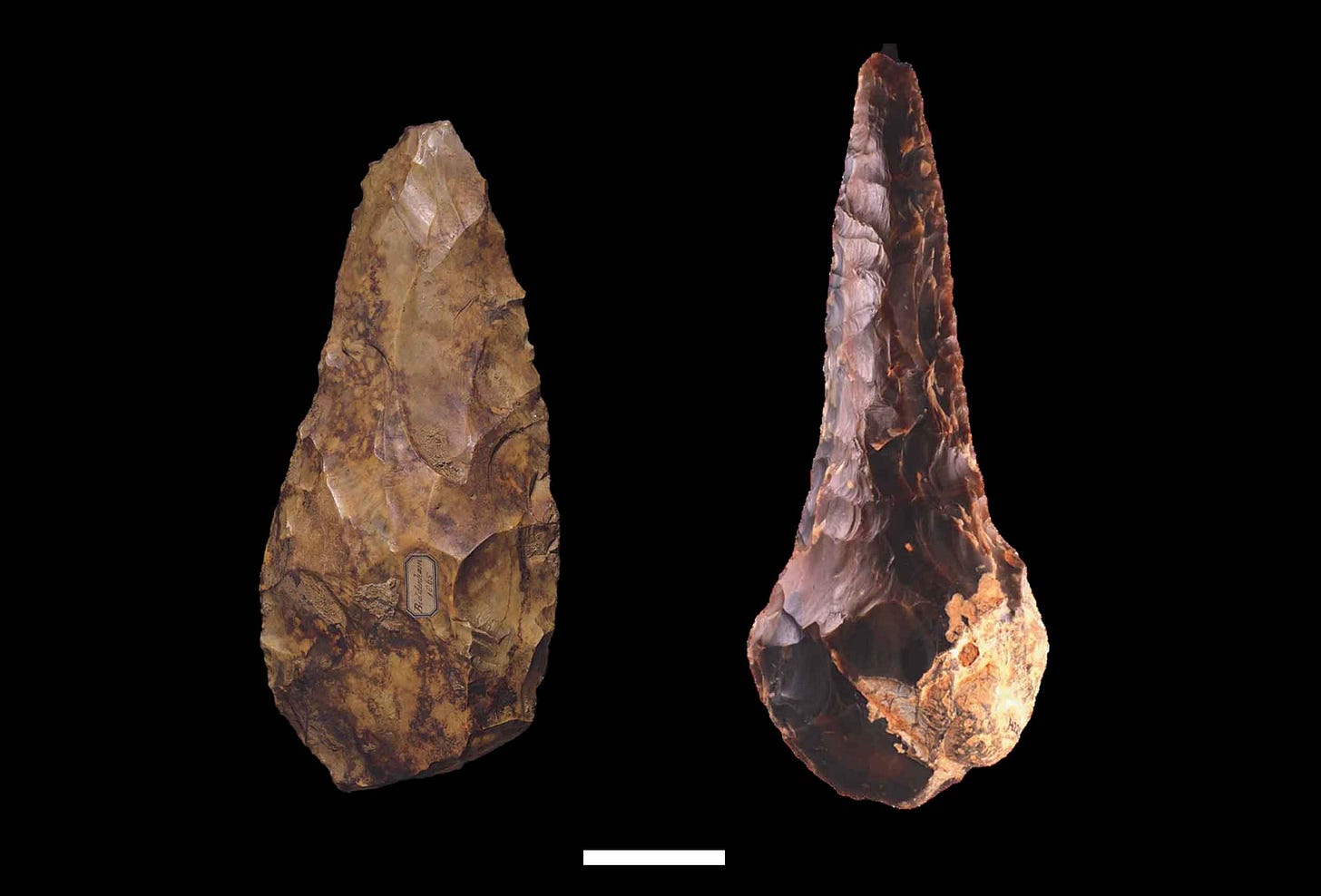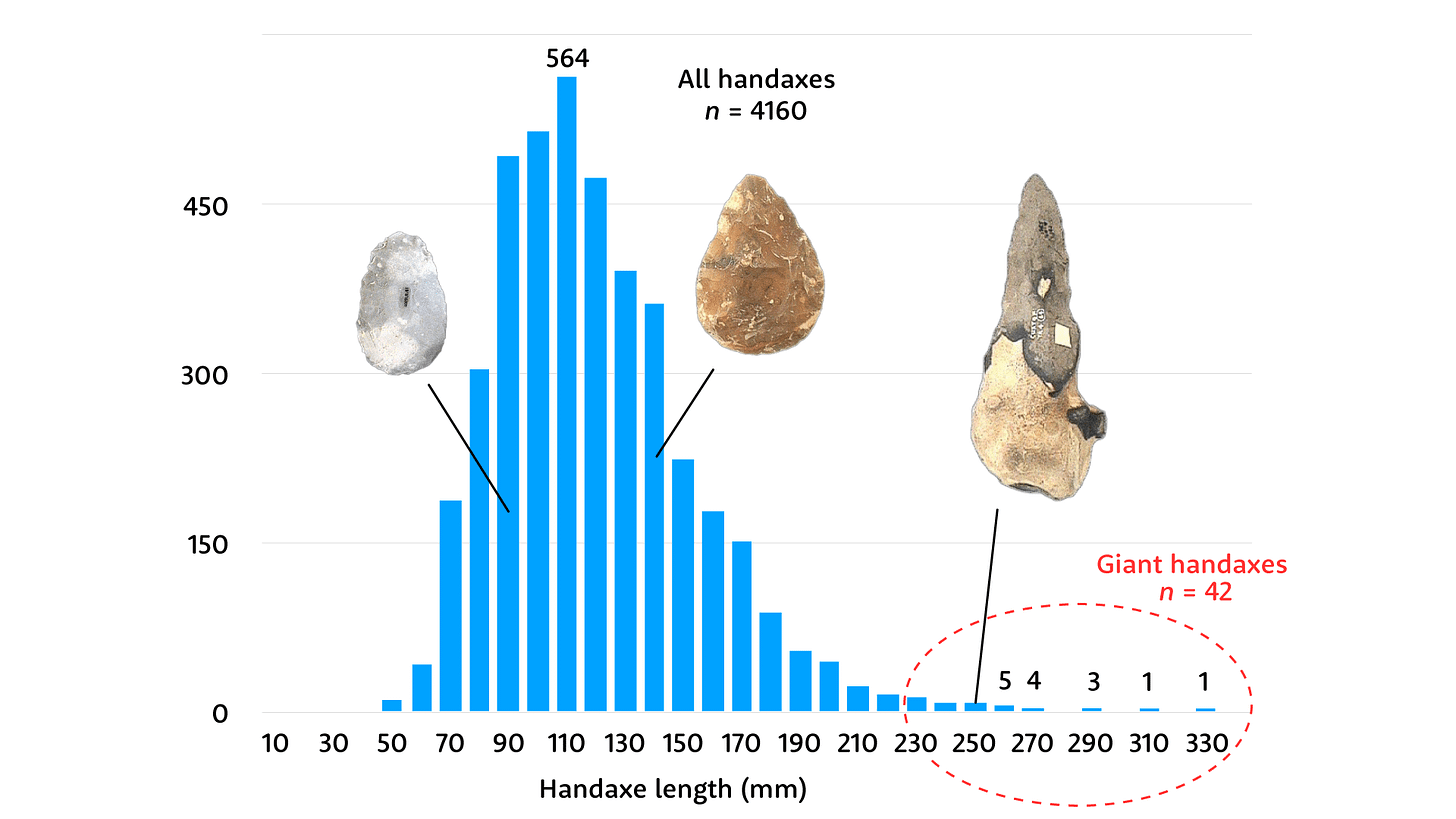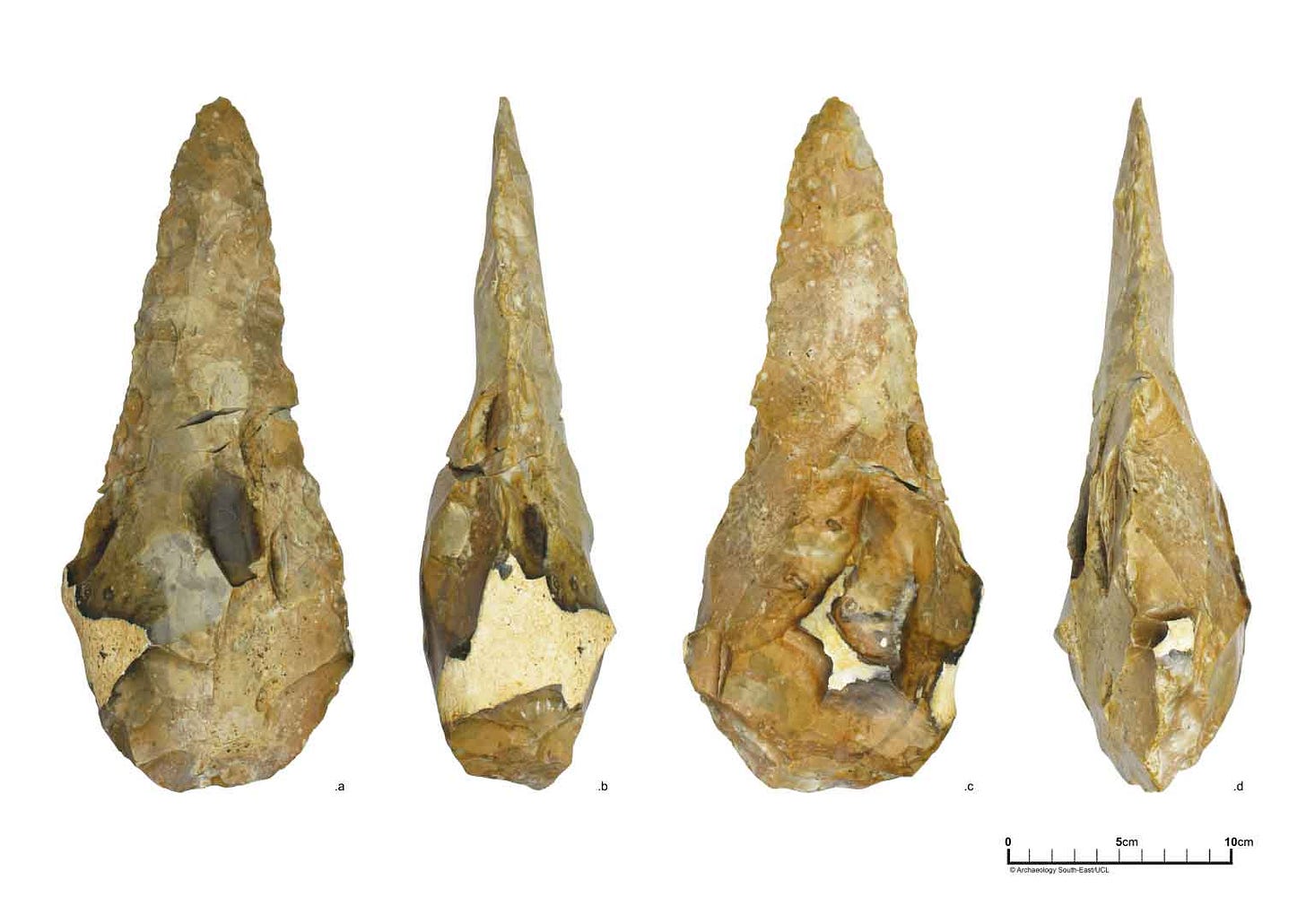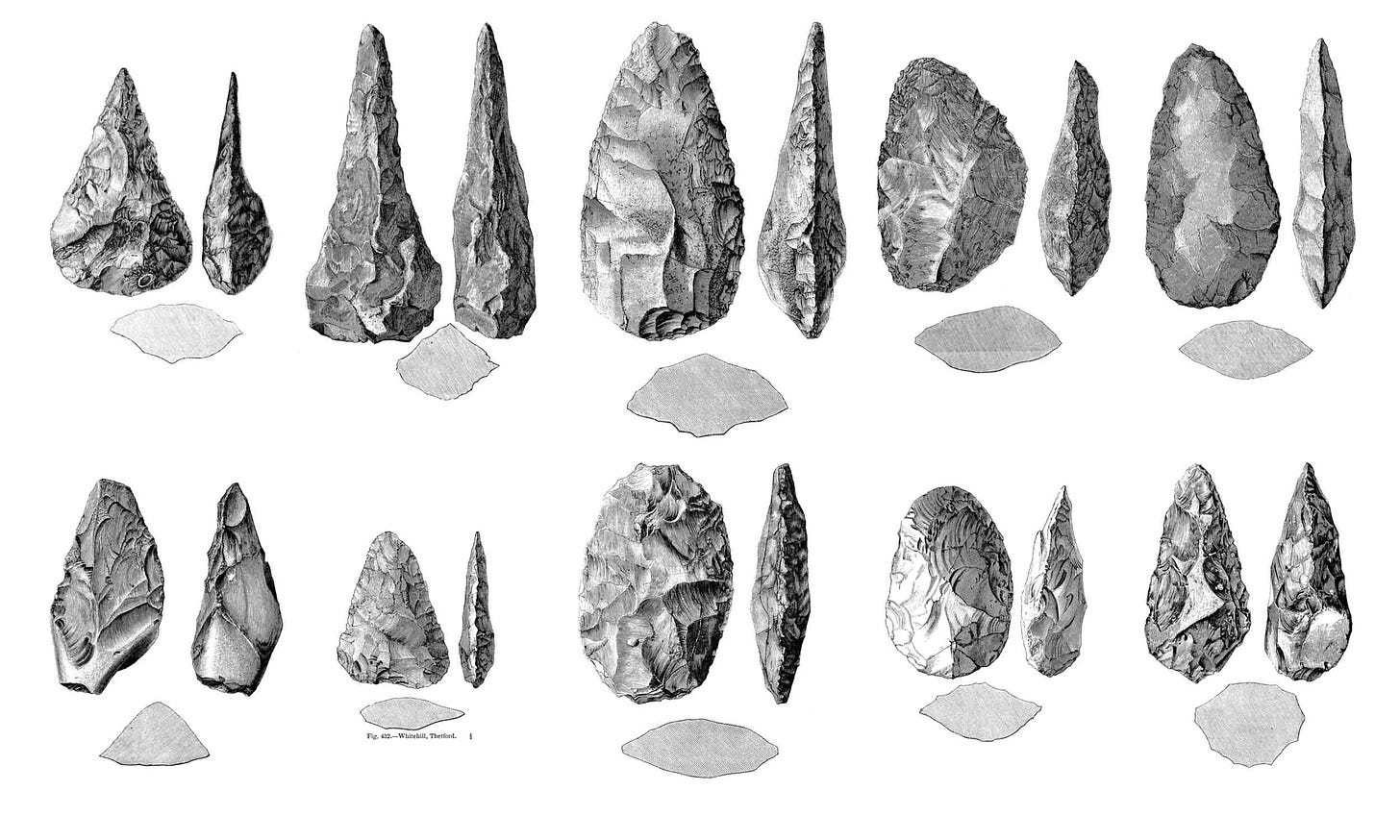Why did the ancients make gigantic handaxes?
Looking at new research on the distribution and function of curiously large bifacial tools

The stone tools known as handaxes have a special place in archaeology. Identifying them is a cinch: roughly oval-shaped, one end usually pointier than the other, and a lens-shaped cross-section that comes from flaking the edge on both faces. Some hominins started making them as early as 1.8 million years ago, and at various times and places since they were the most recognizable stone tools in the hominin repertoire.
Once in a while, archaeologists find a really big one. The most common size is around 10 to 15 centimeters in length, which is already big for a stone tool. The giant ones are double the usual size, going up past 20 to 25 centimeters.
These giant handaxes are a puzzle. Why did anybody make a foot-long flaked object that weighs two kilograms or more, when most similar tools are less than half the length and less than a quarter the weight?
Landing a whopper
Last year, Letty Ingrey and collaborators reported on their excavation work at the site of Maritime Academy, in southeastern England. The archaeological work was undertaken in advance of new construction of the school, and eventually expanded to record and recover archaeological material prior to landscape work that would disrupt the Pleistocene deposits. In the course of this work, the team found what can only be described as a really big handaxe.
With a length of 296 mm, it is one of the longest handaxes ever found in Great Britain. It weighs more than 1.6 kilograms. Elongated toward the tip, the handaxe is the shape known as a ficron, which bears intense flaking activity to create its regular edges and well-defined working end.
The study is a great example of how much attention a giant handaxe can draw. It's a rare artifact that merits a paper describing it in isolation, or that generates news stories about its discovery. Archaeologists don't keep rankings of the top ten sidescrapers discovered in each country, or the most iconic burin. Both specialists and ordinary people think that handaxes are different somehow from other kinds of artifacts. But why?
Mapping the giants
A new study by Luke Dale and collaborators tries to get to the bottom of the giant handaxe phenomenon by looking at where and when they were made. Giant handaxes have been found in many parts of the world, and a truly global picture is beyond any one analysis. So Dale and coworkers focused on Great Britain, where many other archaeologists have already put a lot of work into building a database of handaxes from a wide range of sites.

In a survey of more than 4000 handaxes of all sizes found across Britain, the researchers found that the lengths of these artifacts basically form a bell curve. The so-called giants are just the right tail of this distribution, and a very thin tail at that. Only 42 artifacts, around 1% of the total, were longer than 220 mm from butt to tip.
I think it's important that such a small fraction of handaxes are giants. It suggests that these were not a special category of tool to the ancient hominins who made them. Maybe a user of a giant would notice that it was an outlier—how could they not? But the tail of a normal distribution is an inevitable phenomenon from a process that has many potential sources of variation. Some handaxes are giants because, well, sometimes things happen when you're making a handaxe.
Dale and coworkers mapped the sites with giant handaxes and reviewed their geological ages. They found that most of the giants came from the latest phase of time with Acheulean sites in Britain, Marine Isotope Stage (MIS) 9, which dates to around 340,000 to 300,000 years ago. The most common areas for the 42 giants to have been found were in southern England in and around the Thames valley. Both these are characteristic of the broader distribution of handaxes: For example, out of the total of 4160 handaxes in the data, 2808 of those come from the MIS 9 period. Compared to 67% of all handaxes, 90% of the giant ones come from MIS 9, so it's a bit higher fraction but on a small sample of 42.
Probably the most telling statistic is that the presence near sites of suitable raw materials did not determine the presence of giant handaxes. Hominins who made handaxes brought them to some places where the local stone was not very good for handaxe manufacture, and that was true of giants also. Dale and coworkers note one possible utility of a large handaxe is that it can be resharpened or used as a core for sharp flakes. It's never a good assumption that the artifacts from early Stone Age sites were intended by their makers to attain a final form that archaeologists find. Tools went through stages of preparation and resharpening. A large biface carried by one individual may itself have been a source of daughter flakes that were useful for an entire group. In a landscape where hominins sometimes had to carry stone for dozens of kilometers, the purpose of a large tool may have been to persist through many stages of subsequent processing. From that point of view, maybe the bell curve of smaller handaxes is a result of progressive reduction with use.
Digging deeper
One reason why hominins might have made a giant handaxe is because it did some practical job better than a regular handaxe. While many archaeologists have seen this as hard to imagine with such an unwieldy object, there really haven't been many experimental studies to find out just how a giant handaxe might work at many tasks.
That was what Somaye Khaksar and Reza Modarres set out to do in a recent study. Their results have just been published in Journal of Archaeological Science: Reports. The two researchers started out with forty handaxes made out of the same chert: twenty normal sized and twenty giant. Then they recruited twenty volunteers, ranging in age from 17 years old to 70 years old, to use the handaxes for slicing, scraping and digging. The experimenters measured the holes that were dug, timed the slicing and scraping, and tried to work out whether the giant handaxes were better for anything.
“Interestingly, when asked which tool they would prefer to use in a similar context, all 20 participants rejected the possibility of using giant handaxes entirely.”—Somaye Khaksar and Reza Modarres
For slicing, the giant tools were clearly worse. The participants averaged almost twice as long to slice through a block of ballistics gelatin with the bigger handaxes, and every one of them preferred the more regular-sized tools. The scraping went more or less the same between the two sizes of handaxes, with the giant axes giving no advantage in size of or speed. But again, the participants found it awkward and unpleasant to scrape wood using the bigger tools.
What the giant handaxes did do well is dig deeper holes. The greater weight and pointier point both helped in breaking up soil and excavating the hole faster. Unlike the other tasks, the volunteers actually preferred the giant handaxes to dig with. They could grab onto them more easily with two hands and apply more force to sink them into the ground, making the whole job faster and easier.
Khaksar and Modarres point out a drawback of the ancient shovel idea. Lots of foragers today do a lot of digging, and they tend to use digging sticks for the job. Finding a suitable giant cobble or flake and removing hundreds of flakes to make a giant handaxe seems like overkill when a hominin could do the same job with a stout branch. Digging sticks can be longer than even the most elongated handaxe, giving them more leverage and greater underground reach for rooting out the underground storage organs of plants. Plus, sticks aren't brittle and won't break in half with a single snap like a handaxe can.
But after a long look at the Paleolithic wood record, I'm persuaded that hominins used a wide array of digging tools. A few sites have long digging sticks, but many more shorter wooden tools have been unearthed, and many of those shorter tools also seem to have been used for digging. The bone digging implements from a few African sites also were mostly short in length. If ancient people or other hominids were often digging with sticks and branches that were 20 centimeters long, even normal-sized handaxes might have their place in digging for roots, grubs, or other insect foods. The idea that large pointed handaxes could have been digging tools goes back to Boucher de Perthes, who first wrote about these implements in the early nineteenth century, and he may have been onto something.
Signs and portents
For many years the most popular idea about the function of giant handaxes has been that hominin toolmakers created them as signs. This is connected to the broader idea that all handaxes are signs. The symmetry of handaxes, the evident time and effort spent creating them, and their size compared to other flaked stone all combine to make these stand out within the landscape as objects made by minds. If a handaxe is a good sign, a giant handaxe is an even better sign.
I like the idea of handaxes as signs. Anyone who is familiar with flaking stone will tend to recognize stones with flake scars, and when these are strongly patterned—as they are on a biface—then they stand out against a background of more ordinary stones. If someone who has flaked stone is a potential radio receiver, a handaxe is a 40,000-watt broadcast signal.
But the idea has generated a lot of misunderstanding and confusion. In part this confusion was driven by scientists who took the general idea of signs into the direction of genetic determinism. According to some, hominins were “hard-wired” to make handaxes. Maybe a preference for ovoid symmetrical shapes gave some survival advantage and the genes that were selected yielded the side effect of compulsive production of large symmetrical cutting tools. Or, maybe handaxes were part of a sexual selection ritual, in which female individuals chose to mate with the males who made the most perfect model. April Nowell and Melanie Lee Chang wrote a thorough article in 2009 reviewing the idea of genetic determinism for handaxes, discussing what would be necessary for sexual selection on such a cultural trait to evolve. I concur with their conclusion, which is that there is no good evidence for genetic control.
Setting aside genetic determinism, what does it mean for a handaxe to be a sign? The simplest idea is that the handaxe is an icon of its own production. A person who sees it recognizes that it was made. If they've done any knapping, they likely have a good idea exactly how it was made.
We see this all the time today: If a museum or organization wants a logo that means “Stone Age”, they stick a handaxe on it. The only stone artifact that is more present in today's iconography is the arrowhead, and it shares with the handaxe its symmetrical shape, narrowing to a point, and rustic outline. Only the tang sets an arrowhead icon apart. Both icons are widely shared by people around the world: old things that were crafted by people in the past, outside of the lifestyle of cities, villages, and farms. The sharp end of both kinds of artifacts further enables each to serve as an index, pointing toward something. Useful signs indeed.
The archaeologist Penny Spikins has suggested a further way in which a handaxe iconifies its own production. As an artifact, a handaxe is more than a simple expedient, made in a moment to do a job. It takes time and care to create a handaxe, and both the time and craftmanship are evident in the end product. Spikins notes that this attention to detail presents a signal not only about the artifact itself but also about its maker. The maker of a fine handaxe is someone who has followed through on an intricate and challenging plan. A person who demonstrates that that they can learn a craft where others assess their work as cultural products is someone who perceives and responds to social incentives. In Spikins' telling, that kind of sign is very useful in a setting where people are looking for others to cooperate with them.
It's a nice idea, and as Spikins points out, particularly well-made examples have a special value as signs. A giant handaxe might fill the bill in some situations.
Notes: Much more could be added about the aesthetic qualities of bifacial tools and their possible social functions. There's hardly an archaeologist who doesn't have some idea about what handaxes meant to ancient hominins. Personally I think that the most basic sign potential of these artifacts gives an explanation for their long persistence in the archaeological record. The more elaborate explanations are entertaining but probably superfluous.
References
Dale, L., Rawlinson, A., Knowles, P., Foulds, F., Ashton, N., Bridgland, D., & White, M. (2024). Big enough to matter: On the frequency and chronology of giant handaxes in the British Lower Palaeolithic. Antiquity, 98(398), 305–322. https://doi.org/10.15184/aqy.2024.30
Evans, J. (1872). The Ancient Stone Implements, Weapons, and Ornaments, of Great Britain. D. Appleton.
Ingrey, L., Duffy, S. M., Bates, M., Shaw, A., & Pope, M. (2023). On the Discovery of a Late Acheulean “Giant” Handaxe from the Maritime Academy, Frindsbury, Kent. Internet Archaeology, 61. https://doi.org/10.11141/ia.61.6
Key, A., Clark, J., DeSilva, J., & Kangas, S. (2024). Acheulean Handaxes in Medieval France: An Earlier ‘Modern’ Social History for Palaeolithic Bifaces. Cambridge Archaeological Journal, 34(2), 253–269. https://doi.org/10.1017/S0959774323000252
Khaksar, S., & Modarres, R. (2024). How good are giant handaxes in utilitarian functions? An experimental assessment. Journal of Archaeological Science: Reports, 53, 104301. https://doi.org/10.1016/j.jasrep.2023.104301
Marshall, G.D., Gamble, C.G., Roe, D.A., and Dupplaw, D. (2002). Acheulian biface database. ADS, York. https://doi.org/10.5284/1000354
Nowell, April & Chang, Melanie Lee. (2009). The case against sexual selection as an explanation of handaxe morphology. PaleoAnthropology, 2009, 77–88.
Spikins, P. (2012). Goodwill hunting? Debates over the ‘meaning’ of Lower Palaeolithic handaxe form revisited. World Archaeology, 44(3), 378–392. https://doi.org/10.1080/00438243.2012.725889



